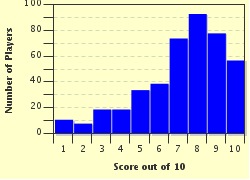Quiz Answer Key and Fun Facts
1. The first question I have to ask myself is: what on Earth am I doing? The pattern I have is entitled "Doctor Who Scarf." What does that title refer to?
2. My first task will be to obtain appropriate knitting needles; mine are made of bamboo. Which of the following plants is most closely related to bamboo?
3. Next, I'll have to choose a yarn. Excellent! I love a good yarn! I think I'll pick the tale of an American folk hero, a man so fast and so strong with his hammer that he had a steel-driving contest with a steam-powered drill -- and won. Who was this railroad-laying man?
4. Drat! It turns out that you need the *fibrous* kind of yarn to knit a scarf. After traveling the land in search of the softest, most colorful yarn, I finally settle on acrylic. Where does acrylic yarn come from?
5. I'm finally ready to start knitting, so I start casting on stitches. Arriving at the middle of the needle, I realize that I am now working on "central casting," which pleases me immensely. What does the phrase "central casting" actually refer to?
6. I'm knitting -- I'm really knitting! Not even my sense of accomplishment can restrain me from a good pun, though, so I call up my best friend and say, "I've got a knit to pick with you!" What is the common expression I'm alluding to, and its meaning?
7. Knitting one row after another, I begin to be reminded of Madame Defarge, a literary revolutionary whose knitting-based codes cause major difficulties for our heroes. In what classic book does Mme Defarge appear?
8. Time goes by; the knitting remains, row after row after row. It's enough to remind me of another friend of mine, who spends a great deal of his time rowing. He and his friends travel down the river in small boats called shells and compete with other teams at regattas around the region. What makes the sport of rowing (or crew, as it's sometimes called) distinct from canoeing and kayaking?
9. After all this work, I think I've actually managed to learn something about knitting. My pattern can be described as "knit one, purl zero": I just use the knit stitch for every stitch of every row, knitting from the right side on odd rows and from the wrong side on even rows. The resulting fabric reminds me of a wedding tradition. What type of fabric is it?
10. At long last, the scarf is nearly complete. All I need to do now is to add a knotted fringe, which should be easy since I've only barely avoided tying myself in knots! I'm driving people batty by constantly referring to this stage of the project as "a fringe science." What does the phrase really refer to?
Source: Author
CellarDoor
This quiz was reviewed by FunTrivia editor
gtho4 before going online.
Any errors found in FunTrivia content are routinely corrected through our feedback system.

